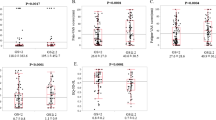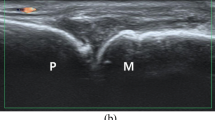Abstract
Purpose
Ultrasound is commonly used to assess the degree of synovitis in patients with rheumatoid arthritis (RA); however, it is unclear which joints are optimal for evaluating and predicting recurrence and remission.
Patients and methods
In 293 RA patients enrolled in the KURAMA cohort, 28 joints were assessed by ultrasound.
Results
Results from patients in remission in both 2015 and 2017 (Group 1, n = 152) were compared with those from patients in remission in 2015 and non-remission in 2017 (Group 2, n = 60). The SMI scores for total (3.1 vs. 6.3, P = 0.004), MCP2-5 (1.1 vs. 2.4, P = 0.03), wrist (0.9 vs. 2.1, P = 0.0003), MTP2-5 (0.4 vs. 1.0, P = 0.03), and Lisfranc joints (0.07 vs. 0.25, P = 0.04) were significantly higher for Group 2. When those in non-remission in 2015 and remission in 2017 (Group 3, n = 27) were compared with those in remission in 2015 and non-remission in both 2015 and 2017 (Group 4, n = 54), the GS–SMI combined score (3.0 vs. 5.0, P = 0.04) and SMI score (1.5 vs. 2.9, P = 0.04) for MCP2-5 joints were significantly higher for Group 4. Multivariate logistic regression analysis identified “wrist SMI score ≧ 1” as an independent prognostic factor for recurrence (odds ratio 3.08, P = 0.001) and “MCP2-5 GS–SMI combined score ≦ 4” as an independent prognostic factor for remission (odds ratio 3.25, P = 0.048).
Conclusion
We identified the optimal joint cut-off scores for predicting recurrence and remission in RA patients. Risk-stratification therapy based on the ultrasound scores may improve outcome and quality of life for patients with RA.




Similar content being viewed by others
References
Smolen JS, Aletaha D, McInnes IB. Rheumatoid arthritis. Lancet. 2016;388:2023–38.
Gaujoux-Viala C, Nam J, Ramiro S, et al. Efficacy of conventional synthetic disease-modifying antirheumatic drugs, glucocorticoids and tofacitinib: a systematic literature review informing the 2013 update of the EULAR recommendations for management of rheumatoid arthritis. Ann Rheum Dis. 2014;73:510–5.
Nam JL, Ramiro S, Gaujoux-Viala C, et al. Efficacy of biological disease-modifying antirheumatic drugs: a systematic literature review informing the 2013 update of the EULAR recommendations for the management of rheumatoid arthritis. Ann Rheum Dis. 2014;73:516–28.
Aga AB, Lie E, Uhlig T, et al. Time trends in disease activity, response and remission rates in rheumatoid arthritis during the past decade: results from the NOR-DMARD study 2000–2010. Ann Rheum Dis. 2015;74:381–8.
Smolen JS, Aletaha D. Rheumatoid arthritis therapy reappraisal: strategies, opportunities and challenges. Nat Rev Rheumatol. 2015;11:276–89.
Stoffer MA, Schoels MM, Smolen JS, et al. Evidence for treating rheumatoid arthritis to target: results of a systematic literature search update. Ann Rheum Dis. 2016;75:16–22.
Felson DT, Smolen JS, Wells G, et al. American College of Rheumatology/European League against Rheumatism provisional definition of remission in rheumatoid arthritis for clinical trials. Ann Rheum Dis. 2011;70:404–13.
Lillegraven S, Prince FH, Shadick NA, et al. Remission and radiographic outcome in rheumatoid arthritis: application of the 2011 ACR/EULAR remission criteria in an observational cohort. Ann Rheum Dis. 2012;71:681–6.
Bechman K, Tweehuysen L, Garrood T, et al. Flares in rheumatoid arthritis patients with low disease activity: predictability and association with worse clinical outcomes. J Rheumatol. 2018;45:1515–21.
Welsing PM, van Gestel AM, Swinkels HL, et al. The relationship between disease activity, joint destruction, and functional capacity over the course of rheumatoid arthritis. Arthritis Rheum. 2001;44:2009–17.
Dougados M, Jousse-Joulin S, Mistretta F, et al. Evaluation of several ultrasonography scoring systems for synovitis and comparison to clinical examination: results from a prospective multicentre study of rheumatoid arthritis. Ann Rheum Dis. 2010;69:828–33.
Mandl P, Naredo E, Wakefield RJ, et al. A systematic literature review analysis of ultrasound joint count and scoring systems to assess synovitis in rheumatoid arthritis according to the OMERACT filter. J Rheumatol. 2011;38:2055–62.
Brown AK, Conaghan PG, Karim Z, et al. An explanation for the apparent dissociation between clinical remission and continued structural deterioration in rheumatoid arthritis. Arthritis Rheum. 2008;58:2958–67.
Scirè CA, Montecucco C, Codullo V, et al. Ultrasonographic evaluation of joint involvement in early rheumatoid arthritis in clinical remission: power Doppler signal predicts short-term relapse. Rheumatology (Oxford). 2009;48:1092–7.
Peluso G, Michelutti A, Bosello S, et al. Clinical and ultrasonographic remission determines different chances of relapse in early and long standing rheumatoid arthritis. Ann Rheum Dis. 2011;70:172–5.
Saleem B, Brown AK, Quinn M, et al. Can flare be predicted in DMARD treated RA patients in remission, and is it important? A cohort study. Ann Rheum Dis. 2012;71:1316–21.
Foltz V, Gandjbakhch F, Etchepare F, et al. Power Doppler ultrasound, but not low-field magnetic resonance imaging, predicts relapse and radiographic disease progression in rheumatoid arthritis patients with low levels of disease activity. Arthritis Rheum. 2012;64:67–76.
Yoshimi R, Hama M, Takase K, et al. Ultrasonography is a potent tool for the prediction of progressive joint destruction during clinical remission of rheumatoid arthritis. Mod Rheumatol. 2013;23:456–65.
Iwamoto T, Ikeda K, Hosokawa J, et al. Prediction of relapse after discontinuation of biologic agents by ultrasonographic assessment in patients with rheumatoid arthritis in clinical remission: high predictive values of total gray-scale and power Doppler scores that represent residual synovial inflammation before discontinuation. Arthritis Care Res. 2014;66:1576–81.
Nguyen H, Ruyssen-Witrand A, Gandjbakhch F, et al. Prevalence of ultrasound-detected residual synovitis and risk of relapse and structural progression in rheumatoid arthritis patients in clinical remission: a systematic review and meta-analysis. Rheumatology (Oxford). 2014;53:2110–8.
Han J, Geng Y, Deng X, Zhang Z. Subclinical synovitis assessed by ultrasound predicts flare and progressive bone erosion in rheumatoid arthritis patients with clinical remission: a systematic review and metaanalysis. J Rheumatol. 2016;43:2010–8.
Kawashiri SY, Fujikawa K, Nishino A, et al. Ultrasound-detected bone erosion is a relapse risk factor after discontinuation of biologic disease-modifying antirheumatic drugs in patients with rheumatoid arthritis whose ultrasound power Doppler synovitis activity and clinical disease activity are well controlled. Arthritis Res Ther. 2017;19:108.
Hata J. Seeing the unseen: new techniques in vascular imaging—superb micro-vascular imaging. Toshiba Medical Systems. https://medical.toshiba.com/download/aplio-500-wp-smi-seeing-the-unseen. Accessed 2 Mar 2019.
Park AY, Seo BK. Up-to-date Doppler techniques for breast tumor vascularity: superb microvascular imaging and contrast-enhanced ultrasound. Ultrasonography. 2018;37:98–106.
Lu R, Meng Y, Zhang Y, et al. Superb microvascular imaging (SMI) compared with conventional ultrasound for evaluating thyroid nodules. BMC Med Imaging. 2017;17:65.
He MN, Lv K, Jiang YX, Jiang TA. Application of superb microvascular imaging in focal liver lesions. World J Gastroenterol. 2017;23:7765–75.
Orlandi D, Gitto S, Perugin Bernardi S, et al. Advanced power Doppler technique increases synovial vascularity detection in patients with rheumatoid arthritis. Ultrasound Med Biol. 2017;43:1880–7.
Yu X, Li Z, Ren M, Xi J, et al. Superb microvascular imaging (SMI) for evaluating hand joint lesions in patients with rheumatoid arthritis in clinical remission. Rheumatol Int. 2018;38:1885–90.
Lim AKP, Satchithananda K, Dick EA, et al. Microflow imaging: new Doppler technology to detect low-grade inflammation in patients with arthritis. Eur Radiol. 2018;28:1046–53.
Yokota K, Tsuzuki Wada T, Akiyama Y, Mimura T. Detection of synovial inflammation in rheumatic diseases using superb microvascular imaging: comparison with conventional power Doppler imaging. Mod Rheumatol. 2018;28:327–33.
Ito H, Moritoshi F, Hashimoto M, et al. Control of articular synovitis for bone and cartilage regeneration in rheumatoid arthritis. Inflamm Regen. 2018;38:7.
Murata K, Ito H, Hashimoto M, et al. Elderly onset of early rheumatoid arthritis is a risk factor for bone erosions, refractory to treatment: KURAMA cohort. Int J Rheum Dis. 2018. https://doi.org/10.1111/1756-185x.13428(Epub ahead of print).
Naredo E, Valor L, De la Torre I, et al. Ultrasound joint inflammation in rheumatoid arthritis in clinical remission: how many and which joints should be assessed? Arthritis Care Res (Hoboken). 2013;65:512–7.
Backhaus M, Burmester GR, Gerber T, et al. Guidelines for musculoskeletal ultrasound in rheumatology. Ann Rheum Dis. 2001;60:641–9.
Szkudlarek M, Court-Payen M, Jacobsen S, et al. Interobserver agreement in ultrasonography of the finger and toe joints in rheumatoid arthritis. Arthritis Rheum. 2003;48:955–62.
D’Agostino MA, Terslev L, Aegerter P, et al. Scoring ultrasound synovitis in rheumatoid arthritis: a EULAR-OMERACT ultrasound taskforce—Part 1: definition and development of a standardised, consensus-based scoring system. RMD Open. 2017;3:e000428.
Padovano I, Costantino F, Breban M, D’Agostino MA. Prevalence of ultrasound synovial inflammatory findings in healthy subjects. Ann Rheum Dis. 2016;75:1819–23.
Guo Q, Wang Y, Xu D, et al. Rheumatoid arthritis: pathological mechanisms and modern pharmacologic therapies. Bone Res. 2018;6:15.
Acknowledgements
This work was supported by a Grant from the JSPS KAKENHI (18K12103).
Author information
Authors and Affiliations
Contributions
HM, AI, MS, MI, YT, and SN have contributed to data collection. HM, AI, SN, MH, and HI have contributed to analysis and interpretation of data. ST helped with statistical analyses. HM, MH, HI, TM, and YF designed and supervised the project. HM wrote the manuscript. All authors critically reviewed and approved the final version of the manuscript.
Corresponding author
Ethics declarations
Conflict of interest
M.H., H.I., and T.M. belong to a department that is financially supported by four pharmaceutical companies (Tanabe-Mitsubishi, Chugai, UCB Japan, and Ayumi). M.H. receives research grants and/or speaker honoraria from Astellas, Tanabe-Mitsubishi, Eisai, and Bristol-Meyers. H.I. receives research grants and/or speaker fee from BMS, Astellas, Asahi-Kasei, and Kyocera Medical. The KURAMA cohort study is supported by a grant from Daiichi-Sankyo. The present study is conducted as an investigator-initiated study. These companies have no role in the design of the study, the collection or analysis of the data, the writing of the manuscript, or the decision to submit the manuscript for publication. H.M., A.I., M.S., M.I., Y.T., S.N., S.T., and Y.F. have no competing financial interests to declare.
Ethical statements
The study was conducted in accordance with the principles set down in the Declaration of Helsinki and was approved by the ethics committee of Kyoto University (R0357). All patients provided written informed consent.
Additional information
Publisher's Note
Springer Nature remains neutral with regard to jurisdictional claims in published maps and institutional affiliations.
Electronic supplementary material
Below is the link to the electronic supplementary material.
10396_2019_978_MOESM1_ESM.pptx
Supplementary Figure. Detailed information about drug usage in each group. Venn diagram showing drug use by each group in 2015. (PPTX 70 kb)
About this article
Cite this article
Matsuo, H., Imamura, A., Shimizu, M. et al. Prediction of recurrence and remission using superb microvascular imaging in rheumatoid arthritis. J Med Ultrasonics 47, 131–138 (2020). https://doi.org/10.1007/s10396-019-00978-8
Received:
Accepted:
Published:
Issue Date:
DOI: https://doi.org/10.1007/s10396-019-00978-8




